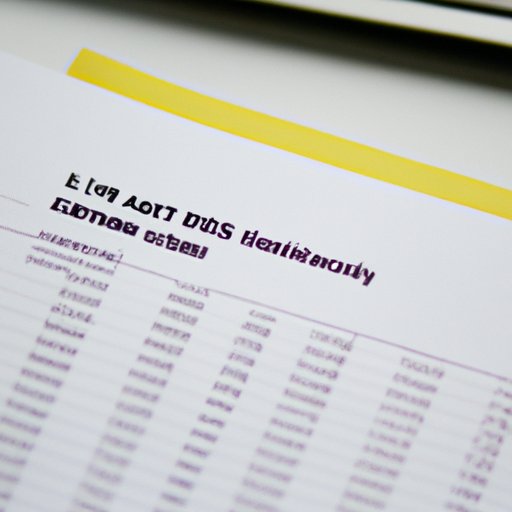Introduction
Financial statements are documents that provide a comprehensive overview of a company’s financial health. They include the balance sheet, income statement, cash flow statement, statement of changes in equity, and notes to financial statements. Understanding these financial statements is essential for investors, as they provide insight into the performance, profitability, liquidity, and overall financial position of a company.

Analyzing Balance Sheets: What Investors Should Look For
The balance sheet is a snapshot of a company’s assets, liabilities, and equity at a specific point in time. Investors should closely examine the balance sheet to gain an understanding of a company’s financial position.
Assessing Assets
The asset section of the balance sheet provides a detailed list of a company’s resources, which can be divided into two categories: current assets and non-current assets. Current assets are those assets that can be converted into cash within one year, such as cash, accounts receivable, and inventory. Non-current assets are those assets that are not expected to be converted into cash within one year, such as property, plant, and equipment. Investors should assess the types of assets a company holds, as well as their relative value.
Evaluating Liabilities
The liability section of the balance sheet lists all of a company’s debts and obligations. These can be divided into two categories: current liabilities and non-current liabilities. Current liabilities are those liabilities that must be paid within one year, such as accounts payable, taxes payable, and short-term loans. Non-current liabilities are those liabilities that are not due within one year, such as long-term debt and deferred taxes. Investors should evaluate the types of liabilities a company has, as well as their relative value.
Calculating Equity
Equity represents the ownership interest of a company’s shareholders. It is calculated by subtracting total liabilities from total assets. Investors should assess the levels of equity a company holds, as well as its trend over time.

Examining Income Statements: Evaluating Profitability
The income statement provides a summary of a company’s revenues, expenses, and net income over a specified period of time. Investors should use the income statement to assess a company’s profitability.
Reviewing Revenues
The revenue section of the income statement provides a detailed list of a company’s sales and other sources of income. Investors should examine the types of revenue a company generates, as well as their relative value.
Analyzing Expenses
The expense section of the income statement provides a detailed list of a company’s costs and other sources of outflows. Investors should assess the types of expenses a company incurs, as well as their relative value.
Understanding Net Income
Net income is calculated by subtracting total expenses from total revenues. Investors should analyze a company’s net income, as it provides insight into its profitability.
Reviewing Cash Flow Statements: Understanding Liquidity
The cash flow statement provides a summary of a company’s cash inflows and outflows over a specified period of time. Investors should use the cash flow statement to assess a company’s liquidity.
Identifying Cash Sources
The cash source section of the cash flow statement provides a detailed list of a company’s sources of cash. Investors should assess the types of cash sources a company has, as well as their relative value.
Examining Cash Uses
The cash use section of the cash flow statement provides a detailed list of a company’s uses of cash. Investors should evaluate the types of cash uses a company makes, as well as their relative value.
Analyzing Changes in Cash Position
Changes in cash position is calculated by subtracting total cash uses from total cash sources. Investors should analyze a company’s changes in cash position, as it provides insight into its liquidity.

Assessing Statement of Changes in Equity: Measuring Performance
The statement of changes in equity provides a summary of a company’s capital contributions, distributions, and earnings over a specified period of time. Investors should use the statement of changes in equity to assess a company’s performance.
Tracking Capital Contributions
The capital contribution section of the statement of changes in equity provides a detailed list of a company’s sources of capital. Investors should assess the types of capital contributions a company receives, as well as their relative value.
Evaluating Distributions
The distribution section of the statement of changes in equity provides a detailed list of a company’s distributions of capital. Investors should examine the types of distributions a company makes, as well as their relative value.
Gauging Earnings
Earnings is calculated by subtracting total distributions from total contributions. Investors should analyze a company’s earnings, as it provides insight into its performance.
Exploring Notes to Financial Statements: Uncovering Supplemental Information
The notes to financial statements provide additional information about a company’s financial position and results of operations. Investors should use the notes to financial statements to uncover supplemental information.
Interpreting Disclosures
The disclosure section of the notes to financial statements provides a detailed list of a company’s disclosures. Investors should assess the types of disclosures a company makes, as well as their relative value.
Applying Accounting Policies
The accounting policy section of the notes to financial statements provides a detailed list of a company’s accounting policies. Investors should evaluate the types of accounting policies a company applies, as well as their relative value.
Analyzing Other Financial Data
The other financial data section of the notes to financial statements provides a detailed list of a company’s other financial data. Investors should examine the types of financial data a company discloses, as well as their relative value.
Conclusion
Financial statements provide important information to investors and understanding them can help investors make informed decisions. This article explored what investors should look for when analyzing financial statements, such as balance sheets, income statements, cash flow statements, changes in equity, and notes to financial statements. By assessing assets, liabilities, equity, revenues, expenses, net income, cash sources, cash uses, capital contributions, distributions, and earnings, investors can gain a better understanding of a company’s financial position and performance.
(Note: Is this article not meeting your expectations? Do you have knowledge or insights to share? Unlock new opportunities and expand your reach by joining our authors team. Click Registration to join us and share your expertise with our readers.)
